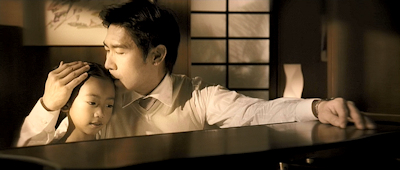
The Legend of Chun-li opens with a shot very similar to this one. This particular flashback comes just under the ten minute mark.

Normally I avoid images with credits, subtitles, or text, but this warrants a special mention because notice how the similar hues, saturations, and values hide Kristin Kreuk’s name.
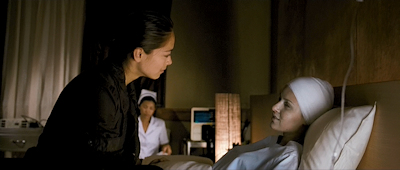
The problem with exploring Chun-li like a drama is that the sick mother becomes a road block to the Street Fighter part of the movie, which is what we came here for. Thus her death is neither sad nor emotional because we can’t wait for her to die.
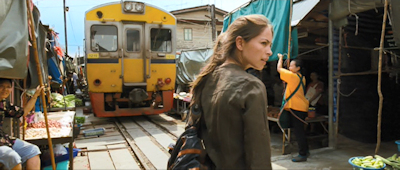
Shot on location in Bangkok, Thailand, there’s a lot of exotic and interesting scenery like this market on the railroad tracks, where everyday displays and covers are pulled back and set back up each time a slow moving train passes.
Review by Jay Wilson There’s a fairly decent little forty-five minute martial arts movie trapped in this pretentious ninety-six minute adventure that somehow still feels bloated despite its brevity due, in no small part, to Legend of Chun-li undermining its protagonist in its misguided efforts to do her justice. We can’t just skip right to Chun-li’s present conflict. No, we have to learn about her childhood, her hopes and dreams, her past, and her inner-most thoughts expressed via voice over. The problem is, and let me go off on a tangent, the opening credits use a tall, narrow, yellow pastel font superimposed on top of bright green grass whose highlights, in sunlight, also appears quite yellow. Not just the credits either. The subtitles too, because Chun-li and her family, being Chinese, don’t always speak English. Yellow font on a green and yellow background. It all blends in. Usually during the opening credits, I can read every bit of text and still take in the underlying scene. Here, I was actually missing part of the movie because I was so focused on separating the text from the image beneath. Getting back to my point: the problem is, if this movie can’t handle easily legible white text with a bit of drop shadow (which, by the way, was established centuries before the invention of cinema) they’re certainly not up to the task of delivering a deep, compelling, and profound character exploration. Giving Chun-li an internal monologue does not give her depth. Making her a classical musician from Julliard doesn’t give her depth. Showing her as a little girl does not give her depth. Depth is not inherent to any of these elements. Rather, these are tools that, when used properly, can yield an intricately crafter character to explore. In the hands of screenwriter Justin Marks and director Andrzej Bartkowiak, they paradoxically tear down the movie’s potential instead of building it up because all they’re doing is wasting time and boring the audience. During the first thirty minutes, I actually preferred the non-Chun-li scenes exploring M. Bison’s rise in power and Charlie Nash’s investigation into Shadoloo’s criminal activity because those scenes explore who these characters are right now, not who they used to be. Who Chun-li was ten years ago is irrelevant. It’s who she is today that we care about. Now, am I suggesting Chun-li have a journey where she does not evolve? No. Far from it. I’m simply asking why Street Fighter: The Legend of Chun-li starts ten years before her journey begins. Why can’t it start when Chun-li is Chun-li? Why can’t she be in the middle of tracking down the man who, in this movie, kidnapped her father? There still is room for her to grow and evolve within this framework. The most obvious avenue would be to make the search for her father double as a journey of self-discovery with Chun-li finding out who she is as she finds out who her father was and, yes, where her father is now. Right there is a character arc intertwined with, and thus relevant to, the plot—not to mention this would make the overabundance of flashbacks actually have a point. You know what else you can do? You can throw complications at Chun-li: establish that she, as a young adult, is no match for Bison or his henchmen. Now she has an obstacle to overcome. Now she has a chance to prove her determination and her perseverance, developing Chun-li into an intelligent, capable, and adaptable character who gets things done which will also make her sympathetic as an inherent bonus. Plus if Chun-li comes back from getting beat down by Bison and his thugs (physically or metaphorically), it’ll give actual meaning to that noble hero quote the movie keeps trying to inspire us with: “Standing up when standing’s not easy.” 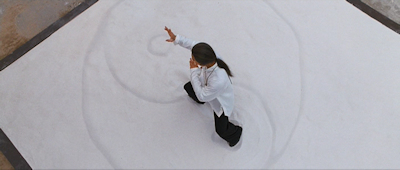
The botched opening credits might lead you to believe the entire movie is hopelessly incompetent. It’s not. There are plenty of nice shots and well-constructed sequences such as Chun-li’s new mentor, Gen, demonstrating his form.
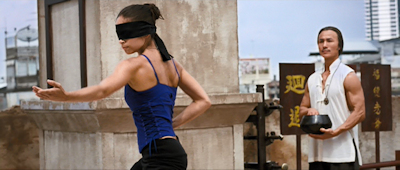
While I like Legend of Chun-li when she’s hunting for Bison and training under Gen, it would have been nicer if her training had an arc to it. She spars with Gen once and loses, and then there’s this scene where she passes her test.
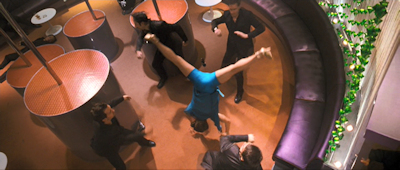
Really? You couldn’t have made Chun-li a cop, like the games, which would have transitioned seamlessly to live action, yet you kept the ridiculous, physics-defying Spinning Bird Kick?
Seriously? 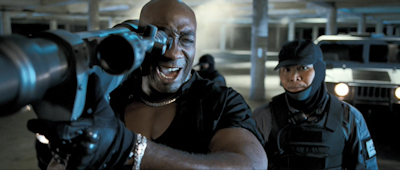
Michael Clarke Duncan lights up the screen as M. Bison’s vicious enforcer, Balrog, and he’s surprisingly given a lot to do in comparison to the cameos he typically receives in most adaptations.
Starting the movie when Chun-li’s father is kidnapped sounds like a good place to begin because technically that is when its central conflict begins, but the problem is it’s not when Chun-li’s story—her journey—begins. Chun-li doesn’t begin her search for another decade, leaving the gaping question, “Why didn’t she start sooner?” Yes, obviously, she can’t effectively locate a kidnapped parent when she’s ten, but why not at least ask questions in her teens? Why not hire a private investigator when she reached adulthood? Why not change career aspirations and go into law-enforcement to try and find him? It seems like she’s content to forget about her father until a mysterious scroll drops in her lap and someone literally tells her, “Yes, you can find your father.” These issues aren’t an issue in a drama. The problem with Chun-li evolving from a pianist in an action, martial arts movie is it doesn’t do anything for her action, martial arts conflict. It’d be perfect as a miscellaneous detail that the narrative doesn’t focus on—maybe the music playing in her father’s prison is her concert performances—and that’s fine. There’s nothing wrong with little pauses here and there to suggest character depth, but this movie wastes twenty minutes on setup with no payoff. The aforementioned scroll is never seen or mentioned again. Meanwhile the very heartbeat of the movie gets left on the cutting room floor. As mentioned three paragraphs ago, running parallel to Chun-li’s coming into adulthood story are the more interesting M. Bison and Charlie Nash stories. Towards the end, Chun-li shows up in Charlie’s safe house and asks for backup even though their previous interaction amounts to precisely one split second where she happens to see him across a crowded room, pointing a gun in her direction while she’s fleeing from other men with guns—men who are shooting at her. She doesn’t even know the guy’s name, yet she magically knows where he is and that he’s a good guy. So, what’s on the cutting room floor? Everything. Literally everything. There’s a whole subplot about Charlie’s deceased daughter completely jettisoned. Not only was it there, but it was woven into the narrative gradually and non-intrusively, using natural pauses in the action to flesh out his character and bring him closer to Chun-li. On a stakeout, Charlie’s partner notices a photograph and asks him about it. Later on, Chun-li shows up at his safe house—still no word on how she found him, but I didn’t say the deleted scenes made it a perfect movie—and Charlie acts on a hunch, removing the clip from his gun, setting the weapon down, and they talk. And while talking, Chun-li notices the picture of Charlie’s daughter, she asks about it, and a bond forms between them—he a father who lost a daughter, and she a daughter who lost a father. Now I can believe she’d go to him for backup. As is, Charlie can almost be cut entirely without impacting anything because he and his partner seem to run perfectly parallel with no intersections to the main plot, like they’re part of a spin off movie—a completely separate entity—that got absorbed into this one. There’s more, much more, such as Charlie’s attempt to track down Chun-li which is immediately stonewalled by the residents of Bangkok who are protecting her. Why are they protecting her? Well, she was supposed to be setup as a vigilante, combating the rampant crime on behalf of the innocent. In the final cut, she helps exactly two people after ignoring one robbery at gunpoint with voice over indicating she ignored many more. A deleted scene has her helping a third person, which wouldn’t have made the difference—a montage was needed to make her Thailand’s Robin Hood—but it would have been a step in the right direction. Not to mention, at one point a major character gets blown up with a rocket propelled grenade; he miraculously appears later on, seemingly unscratched. Missing is the scene where he goes sleeveless, showing his arms severely scarred whereupon Chun-li directly comments on the disfigurement, calling attention to it, so his convenient reappearance doesn’t quite reek so much of amateurish fanfiction. 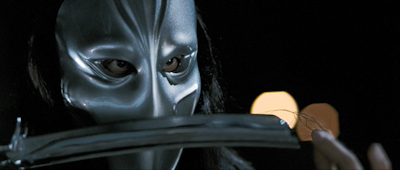
There actually is a great little moment where Vega, mid-fight, pulls off a few severed hairs from his claw, and Chun-li blows on her newly cut bangs.
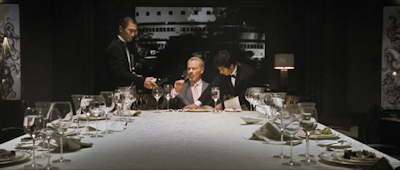
I do love how cold Bison is, having a comfortable meal with fine wine, completely undisturbed by the sounds of his rival crime lords getting slaughtered.

In the DVD commentary, the producers discuss how the chi-ball is the only way to defeat Bison; however, no such information is related in the film proper—not even in the deleted scenes.
The chi-ball is just there. But you know what the movie has plenty of time for? Flashbacks. From the pointless and stupid origin of Bison where we see a glimpse of the evil crime lord not just as an infant but also as a common thug and even as a soon-to-be father in a laughable scene where he transfers the good in his soul into his soon-to-be-born daughter, delivered moments later via caesarian section using only his fingertips. To the redundant where we flash back ten minutes to the opening scene with a young Chun-li playing piano while her father watches and listens; he gets abducted in the very next scene, and then we cut to Chun-li as an adult, playing the piano and remembering her father. To the incredibly redundant where we flash back to something that happened in the same scene. Chun-li sees a man getting beaten up by thugs. As they walk away, she runs up to the victim, and the camera pushes in on the prone pedestrian’s hand, filling the entire frame with a tattoo of a spider web. Ten minutes later (twenty minutes into the movie), Chun-li visits a market and runs across a guy sweeping the street who deliberately blocks her path until he forces her into the tent of an antiques dealer. Again, the camera pushes in on the man’s hand, once again filling the frame with the exact same tattoo. Sixty seconds later, Chun-li sees the spider-web symbol in a book, initiating a flashback to both previous encounters—one of which literally just happened—as the mysterious antiques dealer notes that Gen, the man who can help her find her father, might be closer than she thinks. Every camera move—every cut—means something. It says something. Filling the entire frame with a detail tells the audience, “This is important.” Filling the frame with the same detail twice in close proximity, reinforces it. Now, if the explanation of said detail comes thirty minutes later, then you’d have grounds for a brief flashback. Sixty seconds later? We’ve barely finished asking, “What does it mean?” And what exactly does the spider-web tattoo mean? Remember how I said Chun-li was supposed to be a vigilante? That’s what the Order of the Web does. That’s why the people of Bangkok were protecting her. So, in other words, this movie overindulges on unnecessary reminders of what a symbol looks like, yet skimps on the most important part: its meaning. And that pretty much sums up the entire movie: it overindulges on unnecessary reminders of who Chun-li used to be and skimps on both who she becomes and, most importantly, how she gets there, which is pretty sad because those fleeting glimpses we do get—that decent little forty-five minute martial arts movie that leaves behind both voice over and flashbacks and embraces the present conflict? That movie has some pretty wicked action. | ||||||||||||||||||||
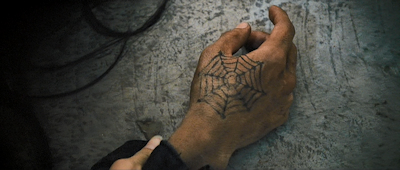
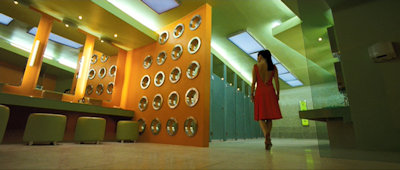
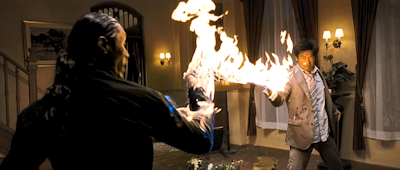
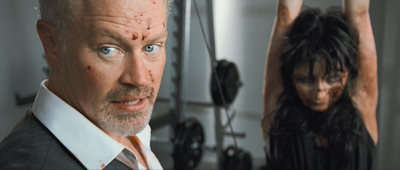
 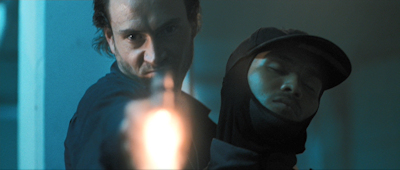


| ||||||||||||||||||||
|
| ||||||||||||||||||||
